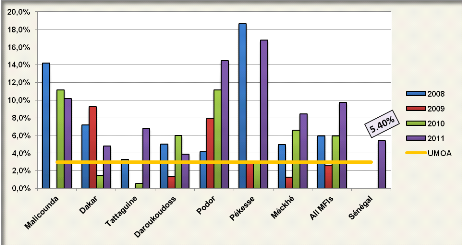CHAPTER FIVE: PERFORMANCES ANALYSES
5.1 Financial Analysis
This chapter which strives to deepen our cognition about how
well the surveyed MFIs are financially performing will be carried out
throughout four crux financial analysis dimensions: portfolio quality,
efficiency, profitability and sustainability. For each dimension, one or two
meaningful devices will merit our attention as it is not possible to go through
the entire financial indicators existing in the microfinance industry.
5.1.1 Portfolio Management
5.1.1.1 A growing loan portfolio
The entire MFIs recorded a global average annual growth rate
of 17% in the last four years. However a deepened analysis of the portfolio
points out that merely 86% of the MFIs are really growing with an average
annual growth rate fluctuating between 39% and 679%.
Surprisingly the growth rate is more noticeable at the MEC MFR
of Malicounda albeit appearing as the youngest, chiefly because boosted by the
investment funds of the FAIR in 2010 and 2011. Besides, corresponding trend is
observed at the MEC FAM of Dakar which presents likely 17% of average annual
growth rate. The two MFIs growth might explain their higher leverage ratios
aforementioned.
In opposite, the CREC of Méckhé portfolio has
constantly winced over the past four years (annual average of -47%) entailing
the total portfolio score of the seven MFIs. This might be explained mainly by
the decrease in the number of borrowers induced by the new credit policy which
stress out a better clients' screening, a reduction of agricultural loans, a
focus on lending to associations rather than individuals, a repayment of
borrowed funds; and meanwhile by the decrease in credit line and the
momentaneous cease of the FAIR in 2010. Nonetheless, the MFI still maintains
the crux outstanding loan portfolio thus contributing of 26% to the total
outstanding loan portfolio in 2011.
The MFIs of Pékésse, Daroukoudoss, Koyli
Winrdé and Tattaguine show up a relatively stable score with some kind
of rational growth which can be easily controlled comparing to other MFIs.
Despite this growth trend, only three MFIs (43%) held 69% of
the outstanding loan portfolio in 2011: the CREC of Méckhé (26%),
the MEC of Podor (23%) and the MEC of Tattaguine (20%).
5.1.1.2 A fluctuating portfolio at risk
One of the crux indicators appraising how well a MFI is
managed or performing remains its portfolio quality, commonly assessed through
the portfolio at risk (PAR). It integrates the entire outstanding loans
holding at least one arrears as well as the rescheduled loans. In the UMOA
region, and in accordance with the regulation and the BCEAO instructions on
periodic reports, the portfolio at risk usually appraised is the PAR after 180
days (PAR>180 days). The figure 8 presents the PAR 180 days for the surveyed
MFIs.
Figure 8: Portfolio At Risk
over 180 days 2008-2011

Source: Our survey (may-august 2012)
The figure 8 reveals important PAR variability between MFIs
and over years.
Considering the entire MFIs, it appears that the PAR increased
from 5.9% to 9.7% in four years. This ratio is higher than the UMOA requirement
(3%) and the national average threshold of 5.4% (MEF/DRSSFD, 2010), and
different from the findings of Lafoucarde, Isern, Mwangi & Brown (2005) of
4% for portfolio at risk>30 days for African MFIs.
Nevertheless, some MFIs present improvement over years in
spite of the improvable score. For example, the MEC MFR of Malicounda performed
from 14% to about 10% in four years.
In contrast, high PAR fluctuations are observed in other MFIs
showing beforehand a lack of a strong credit policy management. The reasons may
be that of the agricultural volatility. In 2011, the PAR of the MEC of Podor
blew up to 14% due to the slump in vegetable sales. In other MFIs such as
Pékesse and Méckhé, members also face a slump of their
fattened cattle and epizootic diseases and livestock robberies. This explains
why the PAR of the MEC of Pékesse has varied inconstantly between 3 and
18% in the last four years.
Yet in other MFIs, there is an increase of the portfolio at
risk over time showing in addition to all aforementioned arguments, a flexible
loan recovery policy which underscores the dialogue and forbids harsh recovery
practices. This is the case of the MEC Koyli Winrdé, the CREC of
Méckhé and the MEC SAPP of Tattaguine which PAR increased in four
years from 4% to 15%; 4.9% to 8.5% and 3.3% to 6.8% severally.
The findings also divulge that the PAR figures recorded may
have been affected by the repayment schedules applied in most of the MFIs and
by the bookkeeping and financial statements data. Indeed, some overdue loans of
more than one year are still kept in books in some MFIs.
It appears important for MFIs to implement a better loan
monitoring system which will systematically track their PAR especially for long
term loans with annual instalments or bullet repayment. That's why the
provision should respect the standards set up by the regulation. An analysis of
the risk coverage ratio pinpoints that most of MFIs do usually not make the
required provision to cover their PAR even though some provisioning are made.
These practices are opposite to the common understanding of systematic loan
losses provision to preserve client deposits especially in deposits- based
MFIs.
| 

